Planting hydrangeas in the fall in open ground: rules of care and cultivation
On the surface lies the fact that hydrangea is one of the most beautiful plants, which is increasingly found not only in decorating urban park areas, but also in the backyards of country houses. And if you already had thoughts about growing a magnificent shrub flower with your own hands, then do not forget that this perennial requires a special attitude towards itself in the process of planting in the fall in open ground.
About when and how it is best to plant various varieties of hydrangeas, about the features of care after autumn planting (watering, feeding, pruning and sheltering, diseases and pests), and even how to change the color of hydrangeas, will be discussed in our article.

Content
Varieties of hydrangea
The main types of hydrangeas are:
- Panicle (also called garden hydrangea);
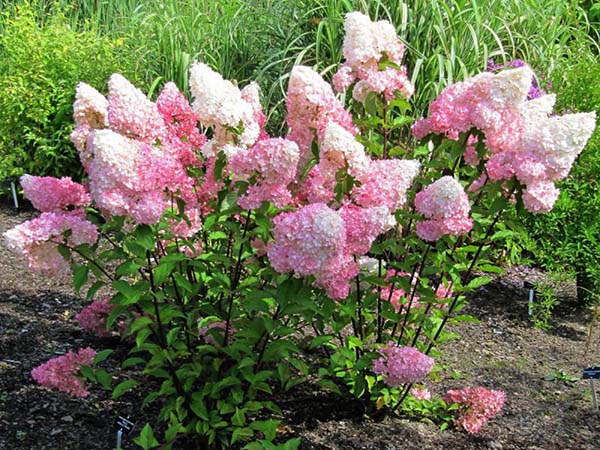
- Large-leaved;
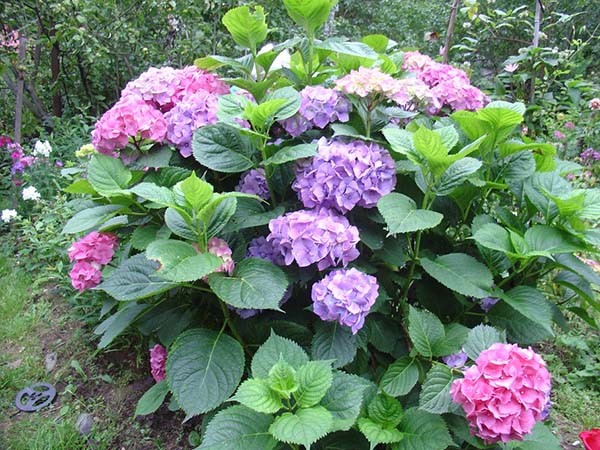
- Tree-like.
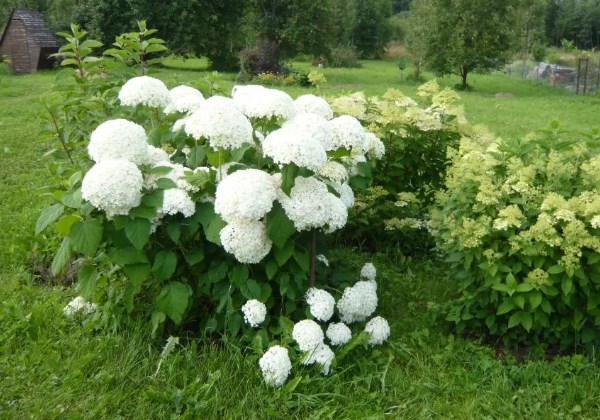
There is also petiolate (curly, climbing) hydrangea, but it is grown much less often.
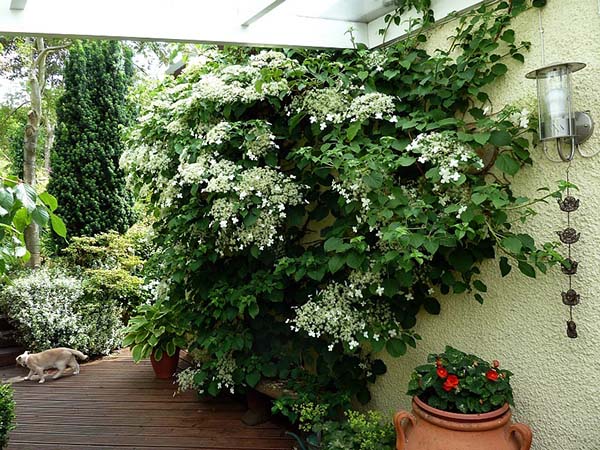
Naturally, each variety has a wide variety of varieties.
Video: types and varieties of hydrangeas
When to plant hydrangea in autumn: optimal timing
In autumn, it is recommended to plant only seedlings with a developed root system (and preferably those that are in pots, that is, with a closed root system), planting very young plants is better to transfer to spring, because they may not have time to settle down before the cold snap.
The approximate timing of planting hydrangeas in the Middle Lane (Moscow region) is September-early October. In the South, the planting of seedlings can be postponed until the second half of October-November.
By the way! Large-leaved (the most frost-resistant, requiring a solid shelter for the winter) hydrangea is usually planted in spring. An exception is the warm southern regions.
Can I plant in spring
Hydrangeas can also be planted in spring. As a rule, it is in the spring that hydrangeas are planted in cold climates, for example, in Siberia and the Urals. In the same Central lane (Moscow region) large-leaved hydrangea (which needs to be covered for the winter) it is also recommended to plant exactly in the spring, approximately in the second half of April-May.
Hydrangea breeding methods
This article will talk about planting in open ground in the fall ready-made seedlings hydrangeas, but you can grow these beautiful flowers from seed, however, this is difficult and time consuming to do. Where toto propagate hydrangeas faster and more efficiently layering, dividing the bush (used when transplanting) or cuttings (the most popular way).
How to plant a hydrangea outdoors
In order for the hydrangea planting to achieve its result, it is necessary to responsibly and thoughtfully approach the selection and purchase of a seedling, find a suitable place in the garden, properly fill the planting hole with acidic soil and, finally, plant the seedling itself in the open ground.
Choosing and buying a seedling
Naturally, when choosing a hydrangea seedling, you should carefully examine it before purchasing.
It should be in a pot, the soil which should be wet (but not waterlogged). A seedling must have developed root system (for example, it can look out through the open bottom of the pot), otherwise, after the autumn planting, it simply will not take root. To understand that the hydrangea has long lived and developed in this pot, you can gently grab the seedling and shake the pot.
Important! You should not buy a seedling that has a rotten smell.
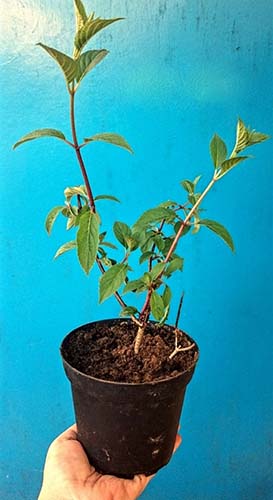
Place in the garden
It is believed that hydrangea is a shade plant, but it will bloom profusely only in a relatively sunny area.
Advice! It is quite acceptable if you plant a hydrangea in a place where the sun is only before lunchtime (until 12-13 pm), or only in the morning or evening (for several hours). Hortense is very fond of afternoon shade.
Paniculata it is better to plant a hydrangea in light shade, in a place that is too sunny, it will fade faster. In addition, it is very demanding on watering, and in the bright sun it will be difficult to maintain constant humidity (you will have to water very often).
And here large-leaved hydrangea - presentplant shadow, it is quite possible to plant it in partial shade.
Important! If you have a very hot climate with a scorching sun, then, of course, it is impossible to plant a hydrangea in an open place; it is better to find a place at least in partial shade.
It is also very important to choose a place well protected from the winds, otherwise, eastern or northern hurricanes will simply break all your hydrangeas.
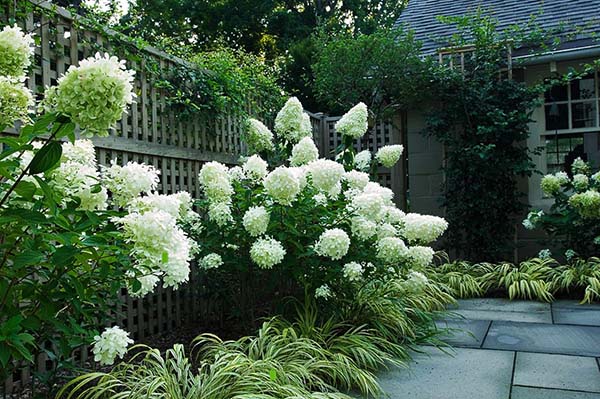
Optimally find a place near the fence, or drop off in the background alpine slide.

And here do not plant under trees, otherwise the plants will lack nutrient moisture and they will begin to compete for it among themselves.
If you do not want the hydrangea to grow alone, then it will be beautiful to plant it nearby or nearby with garden jasmine (chubushnik), spirea or lilac.
Landing pit and soil
The soil for planting hydrangeas requires loose and fertile soil. And the most important thing is that hydrangea will grow well only on slightly acidic soils (5.2-5.5, maximum up to 6.2 pH). To make the soil more acidic, you will need to formulate a substrate based on acidic high (brown) peat. Also work well sawdust of coniferous trees, coniferous litter or pine bark. In addition, the mixture can be added from mineral - superphosphate (60-80 grams) and potassium sulfate (30-40 grams). Remember to mix everything thoroughly.
Important! In no case in the substratecan't add dolomite flour, lime or wood ash, sincethese are deoxidizers, but we need, on the contrary, acidifiers.
Naturally, the size of the planting pit will depend on the size of the seedling itself, as well as the need for additional fertilizers and acidifiers.
For example, if you bought very young 1-2 year old seedlings, then for such a hydrangea it will be enough to dig a planting hole 30 by 30 cm in size, but for adult 3-4 year old seedlings (which will begin to bloom next year) it is optimal to make a hole - 50 to 50 cm.
If you plan to plant several plants, then plant at a distance of at least 1-1.5 meters, because bushes grow quite strongly.
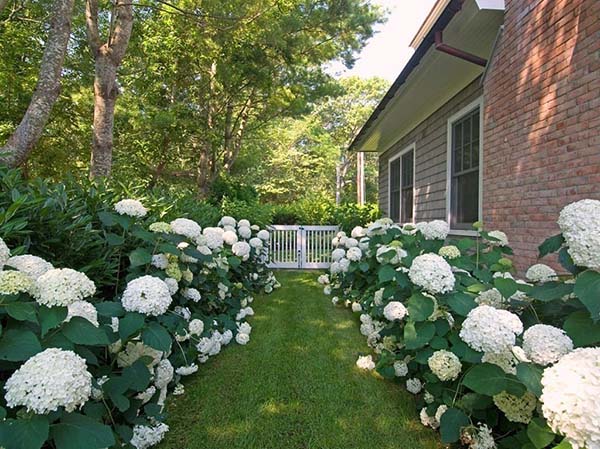
Direct landing
Step-by-step instructions for planting hydrangeas in open ground:
Important! For example, panicle hydrangea, but there are no special differences in planting a tree or large-leaved one.
- Find the most suitable place in the garden.
- Dig a planting hole and add the necessary nutrient and acidic substrate to it.
- Moisten the soil by pouring out a bucket of water.
- Remove the seedling from the pot (after spilling it with water) and place it in the hole. If you have a seedling with an open root system, then you need to put it on a previously poured small mound, and then spread the roots.
- Fill with soil to the root collar so that it is at the level of the soil (if you deepen it too deeply, it can begin to rot) and tamp it slightly.
- Water abundantly.
- If the earth settles, then you will definitely need to fill up. In general, the procedure for watering and adding soil is best done at least a couple of times. This will help get rid of the air between the roots and the ground.
- At the end, be sure to mulch (with high-moor peat, bark of coniferous plants or coniferous litter) with a layer of 5-8 centimeters, because hydrangea loves moisture very much, especially if you planted it in the sun.
Video: planting panicle hydrangea in the fall
Let's repeat! There are no special differences in planting large-leaved hydrangea from planting paniculata, but there are a couple of copyright nuances that you will certainly be interested in.
Video: features of planting large-leaved hydrangea
Outdoor Hydrangea Care
Hydrangea is a perennial with special requirements for soil, watering, top dressing, pruning and shelter, and they just need to be considered for proper care after planting.
Features of care after autumn planting
In principle, all care for hydrangea after planting in the fall is reduced to watering, if it is, of course, necessary, because autumn is rains, which means it is high chance of catching a fungal disease, so as prevention recommended a couple of times shed the soil in the hydrangea trunk circle light pink solution of potassium permanganate.
By the way! Top dressing with potassium permanganate tree hydrangea stimulates the compaction (become thicker and stronger) of the shoots of the bush.
It will be great if you acidify the soil by spilling it a couple of times with citric acid solution, vinegar, or another acidifier.
If you decide to land in the fall large-leaved hydrangeathen don't forget very carefully shelter her for the winter.
Watering
As for the hydrangea, it is better to pour it over than not to add it.this plant is very, very moisture-loving.
If the summer is 30-degree heat, then you need to water the hydrangea, if possible, every day, pouring 1 bucket of water onto the middle bush. Or at least after 2-3 days, but in this case, the portion should be increased to 2-3 buckets, of course, provided that the plant is also mulched.

Top dressing
If you want your hydrangea to always bloom profusely and magnificently, it needs regular and good feeding.
Note! The site already has a detailed article feeding hydrangeas in spring and summer.
In general, the scheme for feeding hydrangeas is as follows:
- At the very beginning of growth (awakening) and for gaining green mass, mainly nitrogen fertilizers and a little potassium and phosphorus.
- During budding - potassium-phosphorus fertilizers.
- During flowering - again potassium-phosphorus fertilizers.
- After flowering (in autumn) - again phosphorus and potassium.
Advice! If you rarely visit the country, then it is optimal to use specialcomplex fertilizers of prolonged action. In other words, in early spring, you need to close up the top dressing in the near-stem circle of the hydrangea, and the plant will gradually receive nutrition almost throughout the season.

There are also special fertilizers for hydrangeas (also suitable for rhododendrons and azaleas).

Acidification
The soil under the hydrangeas for their successful cultivation and abundant flowering should always be acidic, which means that it must be acidified periodically (1 time in 2-3 weeks) (otherwise the plant may get chlorosis).
Here's how to acidify the soil for hydrangeas:
- a weakly acidic electrolyte solution (10 ml per 10 liters of water);
- sulfuric acid;
- vinegar (100 gr 9% vinegar in a bucket of water);
- citric acid (20-40 g per 10 l of water).
Moreover, it is desirable to add to the solution iron chelate or inkstone (20-30 grams per 10 liters).
Garter
If you have planted a tree hydrangea, then when the flowers begin to gain strength, so that they are not bent and broken by the rain and wind, the plant should be tied up if possible. Moreover, this can be done very effectively, so that the inflorescences form a kind of tent.
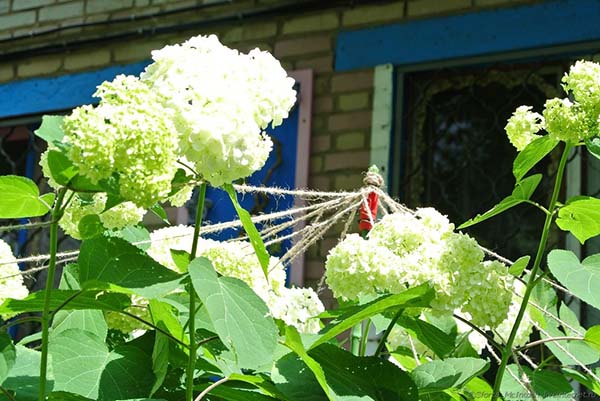
Diseases and pests
As a rule, hydrangea is rarely overcome by diseases and pests, but this happens, so you should know the most typical problems that arise in the process of growing this wonderful flowering shrub.
If you improperly prepare the soil for planting hydrangeas, or if you don’t acidify it periodically, it will become too alkaline over time (due to rainfall and watering), and your favorite hydrangeas will certainly get chlorosis.
It is possible to determine that the hydrangea has chlorosis by the leaves - the leaves become light green, spots appear on them, and they begin to fall off, and the flower ovaries become smaller.
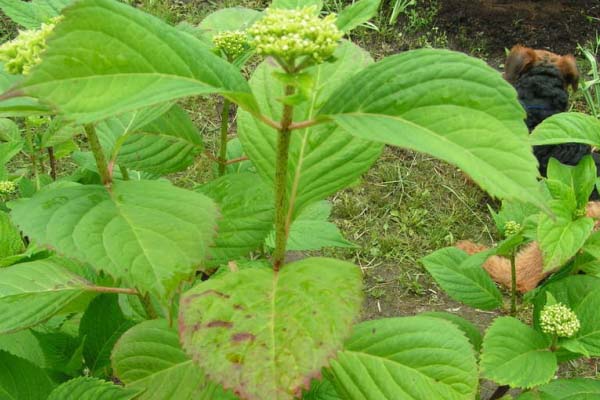
To eliminate chlorosis, you need to take measures to treat the flower, namely, the plant requires an increased amount of iron and an acidifier for its absorption. Of course, you can dig nails or cans into the soil like an old-fashioned way, but this can hardly be called a modern solution to the problem. Where better to use inkstone or iron chelate. As soon as you add a solution prepared with one of the fertilizers, the shrub will recover pretty quickly.
Advice! Do not forget that it is imperative to acidify the soil, for example, with the help of various acids: citric, acetic, sulfuric.
And it is better to prepare a tank mixture: for 10 liters of water you will need 20-40 grams of citric acid and 20-30 grams ferrous sulfate.
It happens that on hydrangea leaves you may notice powdery mildew. Spraying using a solution will help to cope with it. bordeaux liquid or copper sulfate.
Fight other pests such as aphid, spider mite, you can use insecticides such asFitoverm, Fufanon or Aktellik.
Video: diseases and pests of hydrangea
Pruning
Hydrangeas can be trimmed both in autumn and spring, there are no fundamental differences.But often the preference is given to the autumn pruning (before the very frosts), because in the spring it can be difficult to catch up with the sap flow, and after that this procedure is very undesirable, or rather, even prohibited. In addition, hydrangea bushes often break badly due to snow, so it is better if they leave for the winter in a more compact form.
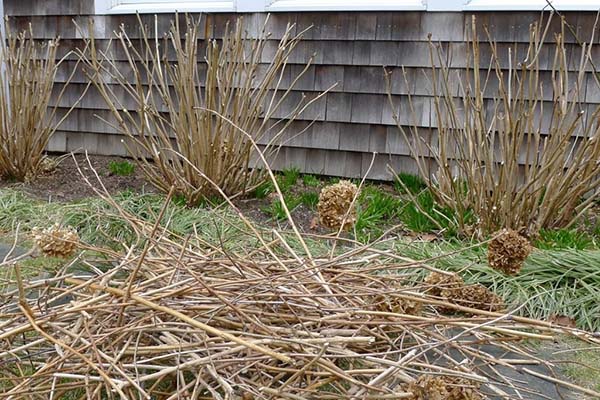
However, even if you cut hydrangeas in the fall, then in the spring or summer (before flowering), you should additionally cut out all thin shoots (less than 1 cm thick).
By the way! More details about pruning hydrangeas (each variety) in spring read in thisarticle, a in the fall — here.
Shelter for the winter
Large-leaved hydrangea is a completely frost-resistant shrub, therefore shelter him just necessary.

Advice for the future! Even in the last spring month (May) in the middle lane it is impossible to completely remove the shelter from large-leaved hydrangeas, because there may still be frosts, the shoots will freeze slightly, and then the hydrangea will not bloom.
But the tree species does not need shelter.
The panicle hydrangea also does not require any shelter. But in order for the plant to winter better, and it is not broken by snow masses (even cut off), it should be lightly tied into a bunch.
Although some growers still additionally mulch the paniculate variety for the winter.
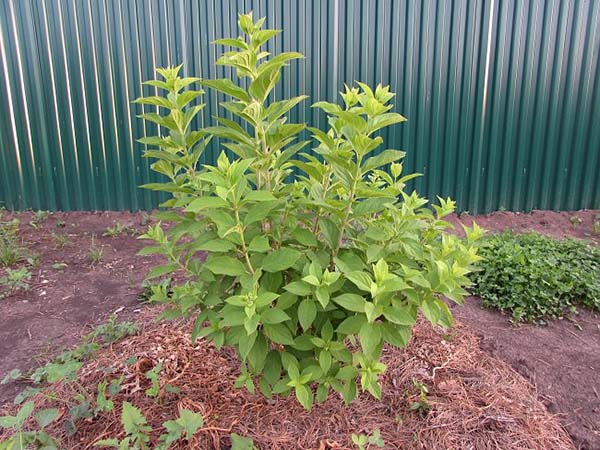
Important! In details about autumn care and preparation of hydrangeas for winter readin this material.
Thus, if you do not like to bother with the shelter of plants for the winter, you need a more unpretentious hydrangea, and your choice is a paniculate and tree-like variety.
Why does hydrangea not bloom or too abundantly
Hydrangea begins to bloom, as a rule, only in the 4th year, and from 5 years old - abundantly. Therefore, in the first year after planting, it may not bloom (although 3-4-year-old seedlings are usually sold).
It is also worth remembering that a lot of sun is required for good flowering. And in no case should you overfeed the plant with nitrogen in the spring.
By the way! The site hasa detailed article about the main reasons why hydrangea may not bloom.
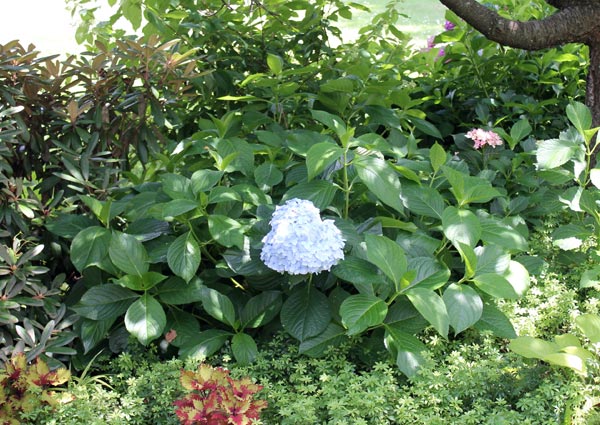
Important! Pruning also directly affects flowering. Without it, for example, it is virtually impossible to achieve a chic and friendly flowering of a tree hydrangea, which blooms only on the shoots of the current year. But it should be understood that this does not apply to all hydrangeas, so it is very important to know the characteristics of your particular variety.
How to change the color of hydrangea: ways
Hydrangea color can be controlled by changing the acidity of the soil. So, the more sour soil, the more purple or blue. If acidity lowerthen it can be pink or crimson.
Thus, if you want to transform pink hydrangeas in blue, then you need to acidify the soil (how this can be done is described above in the “Acidification” subparagraph).
Important! However, making blue hydrangeas from pink is not so easy. It often happens that you seem to have acidic soil, but it is precisely mobile aluminum that is lacking. Or rather, you need potassium alum solution (30-40 grams per 10 liters, consumption per adult plant - up to 2-3 liters), or use aluminum sulfate (dig into the soil, up to 500 grams per 1 square meter).
And if you are tired of blue and wanted pink, then, on the contrary, deacidify. For example, using traditional deoxidizers such as dolomite flour, lime or wood ash.
Interesting! You can achieve a riot of colors on one bush by simply making the soil more acidic on one side and less so on the other.
They even sell special products, after which the hydrangea inflorescences change color.
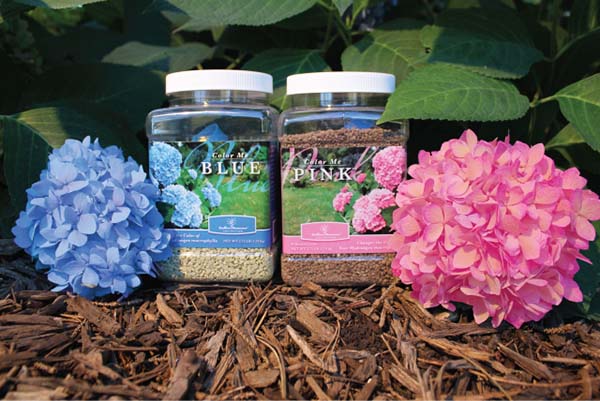
Note! It will not work to change the color of the initially white hydrangea (more often it is tree-like varieties), no matter how much you acidify it.
Video: how to change the color of hydrangea
Thus, in order to properly plant a dazzling hydrangea in the fall, you first need to take into account a number of its inherent features when choosing a seedling, a place in the garden, a suitable soil. Well, now it's all about skillful care after planting: watering, fertilizing, acidification, garter, pruning and shelter for the winter.
Video: care, planting and pruning hydrangeas


Can a small Hydrangea paniculata seedling purchased in the fall be preserved until spring and planted in the spring?
Good day!
Of course, you can, even on the windowsill (but sometimes you have to water), but it is better in a cool, dry basement / cellar. It is only desirable for you to transfer the seedling into a larger (spacious) pot. Naturally, the soil should be slightly acidic, for example, you can take the land for azaleas / violets.
Thank you very valuable advice.
Please tell me if it is possible to plant a panicle hydrangea in October in the Southern Urals ??? I'm afraid that it will freeze and the package will only be in October
You need to navigate only by the weather. Naturally, there is no point in planting in a ground that is starting to freeze, but if the weather is still warm during the day, there are 2 weeks before stable frosts, then you can try to plant it, but in your region, it is probably possible only at the beginning of October. Therefore, most likely, you need to figure out how to preserve the seedlings until spring. If there is a basement or cellar, then in it, if not, then on a cool windowsill and do not forget to water, but it is better to put a humidifier next to it.
Thanks for the information!!!